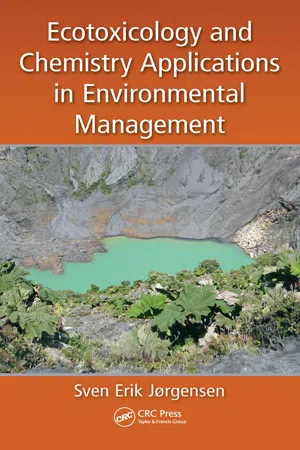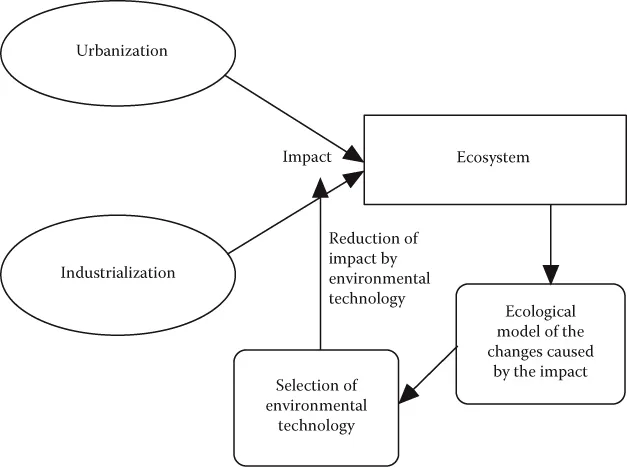1
Application of Ecotoxicology and Environmental Chemistry in Holistic, Integrated Environmental Management
1.1 The Seven Management Steps
Integrated ecological and environmental management means that the environmental problems are viewed from a holistic angle considering the ecosystem as an entity and considering the entire spectrum of diagnostic tools and solutions, including all possible combinations of proposed solutions. Additionally, the experience gained from environmental management in the last 40 years has clearly shown that it is important not just to consider solutions of single problems but to consider all the problems associated with a particular ecosystem simultaneously and evaluate all the solution possibilities proposed by the relevant disciplines at the same time, or expressed differently, to observe the entire forest and not just single trees. The experience has clearly underlined that there is no alternative to an integrated management, at least not on a long-term basis. Fortunately, as presented in this chapter, new ecological subdisciplines have emerged, and they offer toolboxes to perform an integrated ecological and environmental management.
Present-day integrated ecological and environmental management consists of a procedure with the following seven steps (Jørgensen and Nielsen, 2012; Jørgensen et al., 2015):
Define the problem.
Determine the ecosystems involved.
Find and quantify all the sources of the problem.
Set up a diagnosis to understand the relation between the problem and the sources.
Determine all the tools needed to implement and solve the problem.
Implement and integrate the selected solutions.
Follow the recovery process.
The same seven steps should be followed when the pollution problem is a toxic substance, which is the focus of this book. When an environmental, ecotoxicological problem has been detected, it is necessary to determine and quantify the problem and all the sources of the problem. It requires the use of analytical methods or a monitoring program. To solve the problem, a clear and unambiguous diagnosis has to be developed: What are the actual problems ecosystems are facing due to pollution by the toxic substance and what are the relationships between the sources and their quantities and the determined problems? Or, expressed differently, to what extent do we solve the problems by reducing or eliminating the different sources of toxic substances discharged into the ecosystem? A holistic integrated approach is needed in most cases because the problems and the corresponding ecological changes or damages in the ecosystems are most often very complex, particularly when several environmental problems are interacting, including the discharge of two or more toxic substances into the same ecosystem. When the first green wave started in the mid-1960s, the tools to answer these questions, which we consider today as very obvious questions in an environmental management context, were not yet developed. We could carry out the first three points of the above shown list but had to stop at point 4 and could at that time only recommend eliminating the source completely or close to completely by the methods available at that time—meaning environmental technology at a lower level than today. Simultaneously, there were no surveys of the ecotoxicological problems and even not a survey of which toxic substances were causing which types of problems in the ecosystems.
Owing to the development of several new ecological subdisciplines, including ecotoxicology, which was hardly defined as a new ecological subdiscipline 45–50 years ago, it is possible today to accomplish points 4–6. The toolboxes we can apply today to carry out point 4 are presented briefly in the next section and in more detail in Chapters 8, 9 and 10. They are the result of the emergence of three new ecological subdisciplines. For a better diagnosis, the following subdisciplines, namely, ecological modeling, ecological indicators, and ecological services, which are covered in Chapters 8, 9 and 10 for toxic substances, are useful. For points 5 and 6, more tools to solve the problems have been developed today—more advanced environmental technology than we had previously, ecological engineering (also denoted as ecotechnology), and cleaner production, which are presented in Chapters 11, 12 and 13. Environmental legislation in this context could also be mentioned as a tool to abate toxic substance pollution, but for this tool, one can refer to Jørgensen et al. (2015), and to get acquainted with the European legislation for toxic substances denoted REACH, for instance, one can make use of the Internet. A brief presentation of REACH is, however, included in Section 13.7.
1.2 Toolboxes Available Today to Develop an Ecological–Environmental Diagnosis
Massive use of ecological models as an environmental management tool was initiated in the early 1970s. The idea was to answer the question: What is the relationship between the reduction of the impacts on ecosystems and the observable, ecological improvements? (see Figure 1.1). The answer could be used to select the pollution reduction that the society would require and could afford economically. Ecological models were developed in the 1920s by Streeter-Phelps and Lotka Volterra (see, for instance, Jørgensen and Fath, 2011), but a much more consequent use of ecological models started in the 1970s, and many more models of different ecosystems and different pollution problems were developed. In the early 1970s, we had only environmental technology to be used for impact reduction, while today we have more toolboxes as will be presented briefly in the next section. In the late 1970s and early 1980s, several ecotoxicological models were developed (see Jørgensen, 1990) and a procedure to develop environmental risk assessment (ERA) for toxic substances was developed (see Chapter 8).
Today, we have at least a few models available for practically all combinations of ecosystems and environmental problems, including pollution by many toxic substances. The journal Ecological Modelling was launched in 1975 with an annual publication of 320 pages and about 20 papers. Today, the journal publishes 20 times as many papers, indicating that ecological modeling has been adopted as a very powerful tool in ecological–environmental management to cover particularly point 4 in the proposed integrated ecological and environmental management procedure.
Ecological models are powerful management tools, but they are not easily developed. They require in most cases good data, which are both resource- and time-consuming. For toxic substances, the model development requires knowledge of the properties of the toxic substances: What is the equilibrium between soil and soil water? How much does the toxic substance biomagnify through the food chain? How quickly will the toxic substance biodegrade to mention a few important properties? The industrialized countries use about 100,000 toxic substances but only the properties for a limited number of toxic substances are known. Therefore, a system denoted QSAR (quantitative structure activity relationships) has been developed. In most cases, the system is able to estimate from the chemical structure with an acceptable accuracy the properties of chemical compounds. Chapter 4 briefly presents the characteristics of QSAR.
If an economically important and environmentally crucial project is the focus, it is often very beneficial to develop a good ecological–environmental model, but if the project is minor, it may be sufficient to consider other solutions. About 25 years ago, it was therefore proposed to use another toolbox that requires less resources to provide a diagnosis, namely, ecological indicators (see, for instance, Costanza et al., 1992). Ecological indicators can be classified as shown in Table 1.1 according to the spectrum from a more detailed or reductionistic view to a system or holistic view (see Jørgensen, 2002). The reductionistic indicators can, for instance, be a chemical compound that causes pollution, including toxic substances (polychlorinated biphenyls [PCB] is mentioned in this context in Table 1.1) or specific species that by their presence or absence can be translated to ecosystem quality. A holistic indicator could, for instance, be a thermodynamic variable or the biodiversity determined for the focal ecosystem. The indicators can either be measured or be determined by the use of a model. In the latter case, the time consumption is not reduced by the use of indicators instead of models, but the models get a more clear focus on one or more specific state variable, namely, the selected indicator, that best describes the problems. In addition, indicators are usually associated with very clear and specific health problems of the ecosystems, which is beneficial in environmental management. Note that the discharge of toxic substances into ecosystems may cause a significant change in all ecological health indicators. Chapter 9 is devoted to the application of ecological models as a diagnostic tool and Chapter 10 covers the application of ecological indicators and the assessment of ecosystem services with a focus on toxic substance pollution in the environment.
TABLE 1.1
Classification of Ecological Indicators
Level | Example |
Reductionistic (single) indicators | PCB, species present/absent |
Semiholistic indicators | Odum’s attributes |
Holistic indicators | Biodiversity/ecological network |
“Super-holistic” indicators | Thermodynamic indicators as emergy, eco-exergy (work energy) and energy |
Source: Adapted from Marques, J.C. et al. 2009. Marine Pollution Bulletin 58: 1773–1779; Jørgensen, S.E. and S.N. Nielsen. 2012. Ecological Indicators 20: 104–109.
In the last 15–20 years, the services offered by ecosystems to society have been discussed and an attempt was made to calculate the economic values of these services (Costanza et al., 1997). A diagnosis that would focus on the services that were actually reduced or eliminated due to environmenta...

